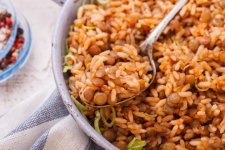d_kakavouli
Active member
Rice pilaf is such a great dish but you don't really see it in many Greek restaurants. Its one of my favorite foods that I ate growing up  Here is the recipe
Here is the recipe
Stir in the coriander, allspice, cinnamon, and bay leaves. Stir in the rice and lentils. Cook the mixture together for about a minute. Stir in the broth, salt, pepper, honey, vinegar, and oregano. Cover the skillet and cook until the mixture comes to a boil. Reduce to a simmer on low heat and cook until all the water absorbs. Stir in the parsley just before serving.
This is what the pilafi will end up looking like

- 2/3 cup dried lentils, soaked in cold water for 2 hours
- 1/3 cup Greek olive oil
- 1 onion, chopped
- 3 large carrots, chopped
- 1 tablespoon ground coriander
- 1/4 teaspoon ground allspice
- 1/4 teaspoon ground cinnamon
- 2 bay leaves
- 3/4 cup uncooked long grain rice
- 2 cups vegetable broth
- 1 teaspoon salt
- 1/4 teaspoon black pepper
- 1 tablespoon Greek honey
- 1 tablespoon red wine vinegar
- 1 tablespoon dried Greek oregano
- 2 tablespoons fresh, chopped parsley
Stir in the coriander, allspice, cinnamon, and bay leaves. Stir in the rice and lentils. Cook the mixture together for about a minute. Stir in the broth, salt, pepper, honey, vinegar, and oregano. Cover the skillet and cook until the mixture comes to a boil. Reduce to a simmer on low heat and cook until all the water absorbs. Stir in the parsley just before serving.
This is what the pilafi will end up looking like




